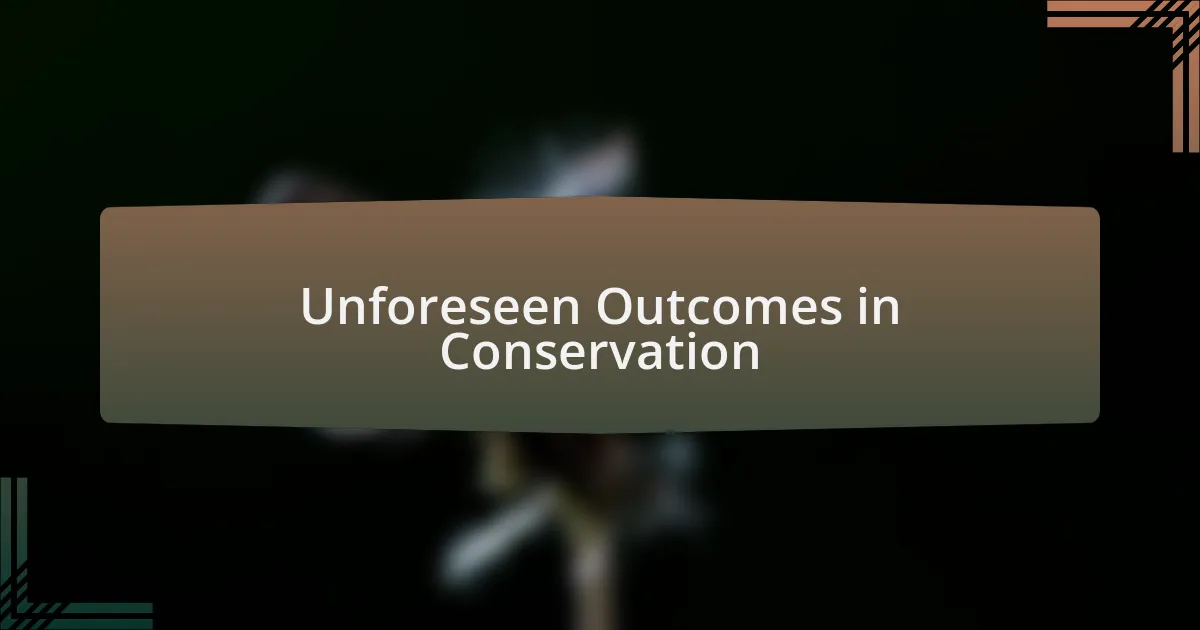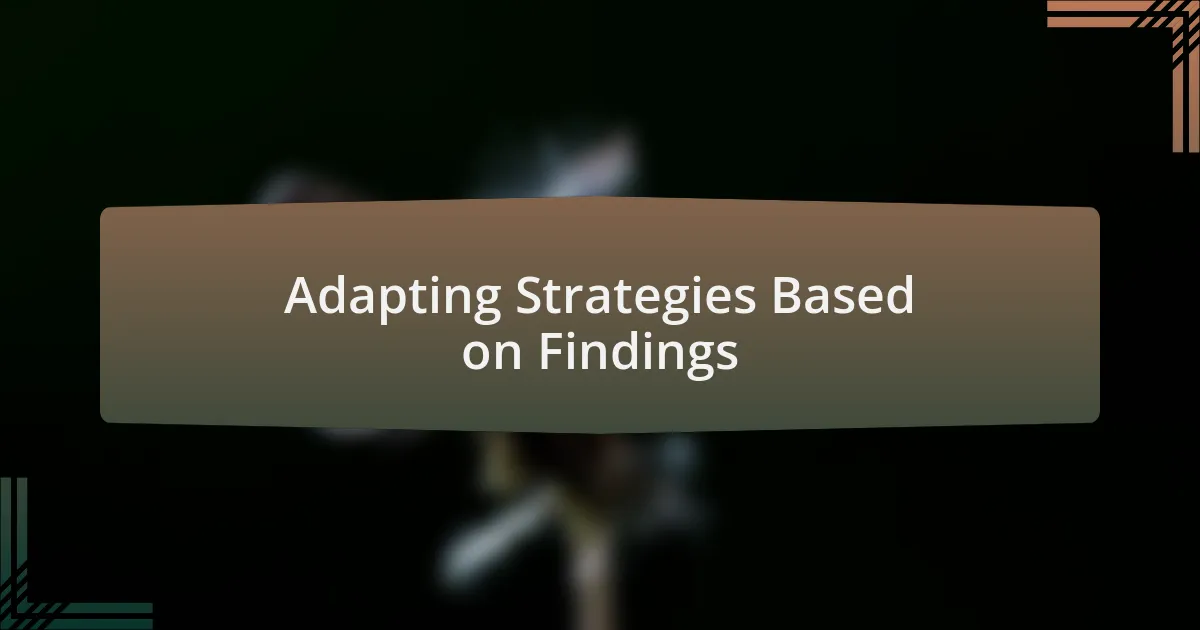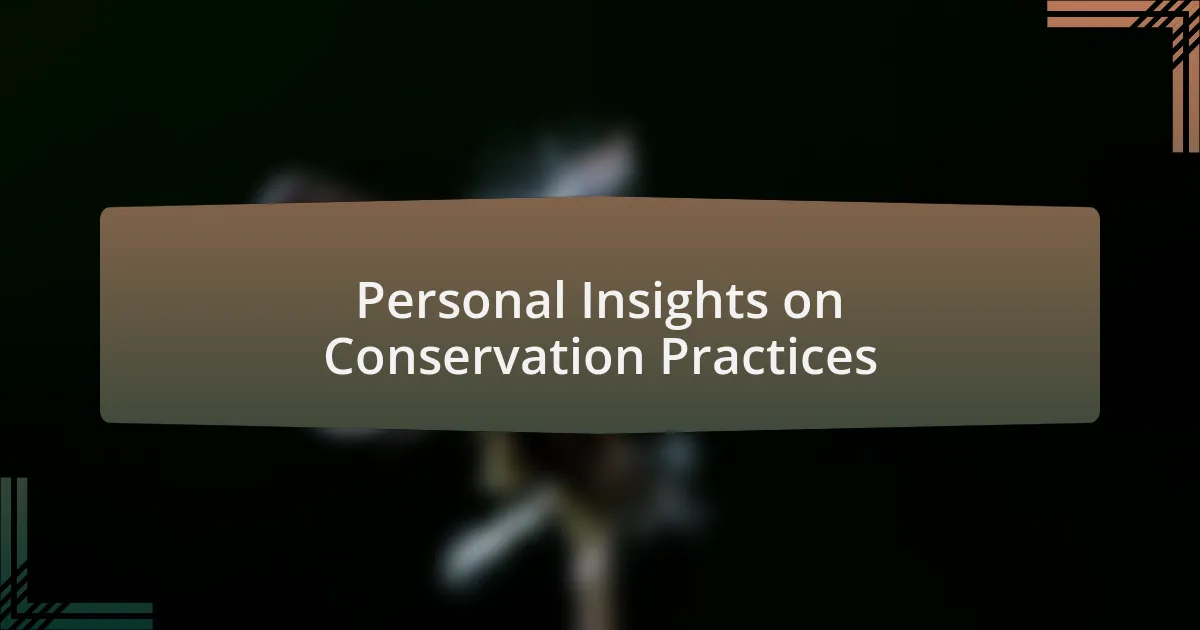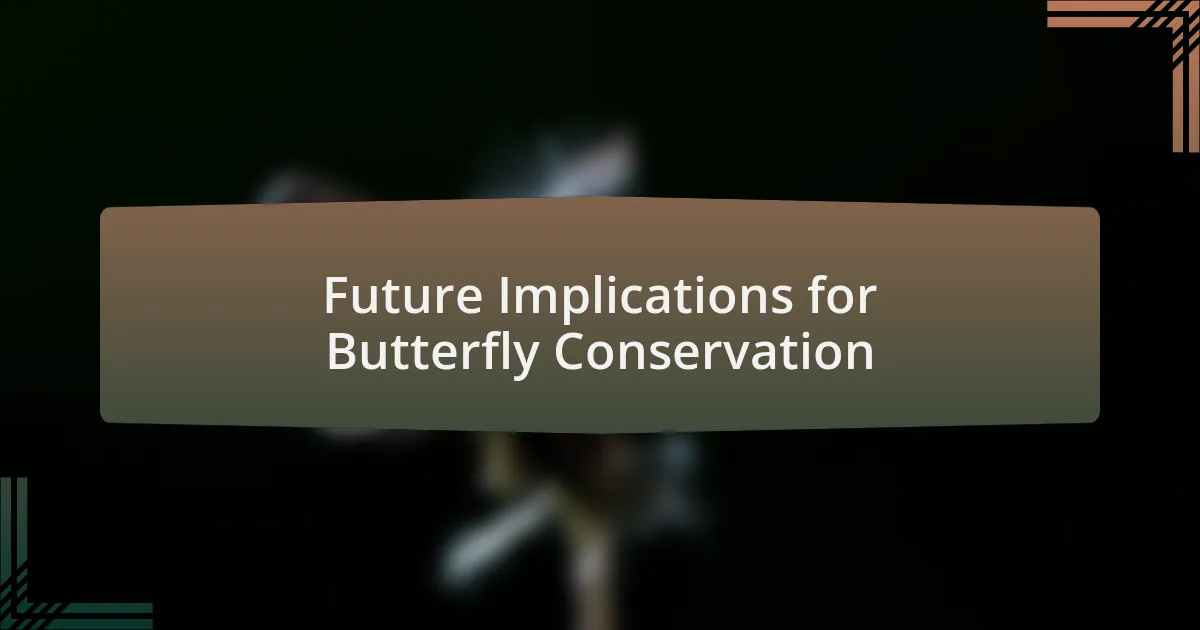Key takeaways:
- Butterfly conservation plays a crucial role in maintaining ecosystem health and engaging communities through education and local actions.
- Unexpected outcomes in conservation efforts often reveal the interconnectedness of ecosystems and highlight the value of diverse perspectives.
- Adapting conservation strategies based on findings and community feedback enhances the effectiveness of conservation initiatives.
- Embracing technology and engaging younger generations are key for the future of butterfly conservation.

Introduction to Butterfly Conservation
Butterfly conservation is more than just a scientific interest; it’s a passionate commitment to preserving the delicate balance of our ecosystems. The sheer beauty of butterflies has always captivated me, but their role as pollinators is vital and often overlooked. Have you ever paused to watch a butterfly flit from flower to flower? It’s a reminder that these creatures are essential, not just for their aesthetic appeal but for the health of our environment.
When I first learned about the rapid decline in butterfly populations, it struck me like a bolt of lightning. The realization that species I admired could disappear within my lifetime was daunting. I remember visiting a local butterfly garden and seeing the vibrant colors dance above me, but I couldn’t help feeling a twinge of sadness knowing that not all communities share the same abundance of life.
Every small effort counts in butterfly conservation, whether it’s planting native plants in our gardens or participating in local monitoring programs. I’ve found joy in sharing the knowledge I’ve gained with friends and family, encouraging them to appreciate the vital role butterflies play. How can we inspire the next generation to protect these incredible insects? I’m convinced that through education and community action, we can foster a deeper respect for these beautiful pollinators and their habitats.

Importance of Butterfly Conservation
The importance of butterfly conservation resonates deeply with me, especially after witnessing the transformation of my own backyard. Once a barren patch, I planted butterfly-friendly flowers and watched in awe as these delicate creatures began to return. Seeing them fluttering around every spring has made me realize firsthand how vital these small actions are for not only butterflies, but for the entire ecosystem.
When I participated in a local conservation project last summer, I felt a profound connection to nature and the larger community. As we worked together to create habitats, I saw children’s eyes light up when they spotted their first caterpillar. This moment emphasized how crucial it is to engage future generations in conservation efforts. It’s not just about saving butterflies; it’s about cultivating a love for the natural world.
Understanding the decline in butterfly populations has stirred my passion for advocacy. With every report of habitat loss or pesticide-related mortality, I can’t help but wonder how we might change the narrative. What if we each planted just one pollinator-friendly plant? This simple choice could spark a movement, strengthening the bonds within our community and ensuring a vibrant future for these essential pollinators.

Unforeseen Outcomes in Conservation
When working on butterfly conservation, we often assume we know the outcomes of our efforts, yet unexpected results frequently emerge. In my own experience, I noticed that introducing native plants not only attracted butterflies but also lured in various bird species I hadn’t anticipated. This ecological domino effect opened my eyes to the interconnectedness of nature and taught me to embrace the surprises that come with conservation efforts.
One striking instance was when I volunteered on a restoration project aimed at reviving a declining meadow. As we cleared away invasive species, I discovered that some of the unwanted plants were serving as shelter for ground-nesting butterflies. Reflecting on this, I couldn’t help but ponder: how many beneficial creatures are we overlooking in our pursuit of perceived perfection in ecosystems? This revelation has reinforced my belief that nature, in its complexity, often holds valuable lessons we can’t foresee.
Engaging with the community during these projects can also yield unforeseen outcomes, sometimes in the form of personal connections. I recall sharing my first butterfly sighting with a neighbor who unexpectedly revealed his childhood fascination with entomology. Our conversation blossomed into a collaborative effort to create a butterfly garden in our neighborhood. It dawned on me that conservation isn’t just about the butterflies; it’s about fostering relationships that can last beyond the gardens we cultivate.

Lessons from Unexpected Results
Unexpected results in conservation can lead to profound insights about our environments. For instance, while conducting surveys on butterfly populations, I discovered that fluctuations in their numbers coincided with local agricultural practices. I was surprised to learn how certain farming methods, which I initially viewed as detrimental, actually created microhabitats that supported an unexpected surge in butterfly diversity. This made me reconsider the impact of human activities; could we find a way to harmonize conservation efforts with agricultural needs?
Another striking lesson came during a butterfly monitoring session at a park where I had often encountered a common species. To my surprise, I observed a rare butterfly—previously unrecorded in that area—fluttering amongst the familiar surroundings. This experience taught me the importance of vigilance and openness to the unknown; sometimes, the most extraordinary discoveries happen when we least expect them. Reflecting back, I wonder: how many hidden treasures lie in familiar spaces, just waiting for our attention?
I’ve also learned that unexpected results often demand a shift in perspective. After undertaking a project in a urban setting, I found that butterflies were thriving in neglected, overgrown lots. Instead of viewing these spaces as undesirable, I began to appreciate their role as unintentional sanctuaries for wildlife. This realization sparked my passion for promoting urban biodiversity. How many of us undervalue the potential of overlooked spaces in our cities? It’s a lesson in humility, reminding us to cherish every nook and cranny of our environment, as they could hold the key to resilience in nature.

Adapting Strategies Based on Findings
Adapting strategies based on unexpected findings has become crucial in my journey of butterfly conservation. For example, I once observed that when native plant diversity was increased in a certain area, it not only supported a wider variety of butterfly species but also improved their health and population sustainability. It made me reflect: how much more could we achieve if we leaned into these insights and adjusted our approaches accordingly?
In another instance, after realizing that invasive species could alter butterfly behaviors unexpectedly, I began collaborating with local communities to manage these plants strategically. This partnership allowed us to harness community insights while addressing ecological challenges. I can’t help but wonder, what other community-led initiatives could unveil solutions that science alone might overlook?
Lastly, my findings during a habitat restoration project highlighted the importance of continual adaptation. When butterflies initially migrated away from a newly restored area, it was disheartening. However, by monitoring their movements and adjusting the habitat features based on their preferences, I learned to embrace flexibility in our strategies. Isn’t it fascinating how nature responds to our actions, teaching us how to fine-tune our efforts for the better?

Personal Insights on Conservation Practices
Throughout my journey in conservation, I’ve found that collaboration often leads to unexpected insights. One memorable experience was when I attended a community workshop on native flora; locals shared stories of butterfly sightings tied to specific plants. Their enthusiasm sparked a realization: sometimes, the best conservation practices come from those who live closest to the land. It made me think—how often do we overlook the wisdom in our neighborhoods?
I vividly recall a project where we tried to introduce a butterfly-friendly garden in a schoolyard. Initially, the design didn’t attract many butterflies, causing frustration. However, after gathering feedback from students and teachers, we learned that certain colors and scents appealed more to local species. This experience reinforced my belief that perspectives from diverse groups can reshape our understanding and outcomes in conservation. Have you ever considered how community feedback could transform your conservation efforts?
Reflecting on my time working with butterfly migration patterns, I realized that patience is paramount. There was a moment when I doubted the impact of our restoration work, seeing minimal butterfly presence initially. But by recording their gradual return, I came to appreciate the slow, yet impactful, process of nature. Isn’t it remarkable how, sometimes, the most profound lessons in conservation come from waiting and observing?

Future Implications for Butterfly Conservation
As I look toward the future of butterfly conservation, I can’t help but think about the role of technology in monitoring butterfly populations. During a recent visit to a local habitat restoration site, I saw researchers using drones to survey areas that were otherwise hard to reach. This innovative approach made me realize that, by harnessing advancements in technology, we can learn more about butterfly behavior and habitats than ever before. Have you ever wondered how data collection could change the way we approach conservation?
Engaging more with the younger generation is crucial for the future of butterfly conservation. I remember hosting a workshop for kids where we made DIY butterfly feeders from simple materials. Their excitement was palpable—and it struck me that nurturing this passion early could lead to a new wave of advocates. How powerful would it be if these kids grew up to become future conservationists, inspired by their involvement today?
Lastly, we must embrace adaptive management strategies that allow us to respond to environmental changes quickly. In my experience with fluctuating butterfly populations due to climate shifts, the ability to pivot our tactics proved vital. Adjusting our conservation methods in real-time can ensure we remain effective, but it begs the question: how prepared are we to adapt our frameworks to the uncertainties of climate change?